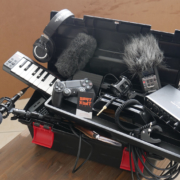In this blog I want to talk about the toolbox of a sound designer. What tools does a sound designer have at their disposal and what are they used for?
The tools
The basics are a computer and a pair of headphones or speakers. For the headphones and speakers it is important that their sound is as neutral as possible, so you know exactly what you are working with. So no bass boost and such for sound design work headphones.
Then we get to the DAW (Digital Audio Workstation). This program is like the workbench of a sound designer. This is where you place your sounds, where you edit and transform them and where you combine them until you have created the perfect sound.
Examples of DAWs are Cubase, Ableton Live, Pro Tools, Adobe Audition and my personal favorite: Reaper.
There are all kinds of tools you can use to transform your sounds in a DAW. Plug-ins such as reverb, echo, compression and distortion to name a few. These can be extremely powerful and helpful to define the sound and character of your audio. This is like your case of drill bits. There are some that you will use the most and there is a whole bunch that are useful in very specific situations.
The materials
Next we get to the materials that we we shape into our product: the sounds. There are different way to gather sounds and each sound designer will have their own preference and approach. Here are three methods for gathering sound effects and the tools used in that process.
Recording your own sounds
The first method is recording your sounds yourself. With this method you have the most control over the sounds you are collecting. You can record items in and around the house, record outside in nature, at a trainstation or wherever you can imagine.
There are a few tools you need for this method. First of all a microphone. Depending on what you are recording the type of microphone you need can differ. The most versatile microphone at my disposal is my shotgun microphone, it can be used for most of the recordings I have to do.
Besides a microphone you also also need a recorder that saves the recordings from your mic onto an SD-card and that you can use to alter the recording settings. Some recorders like the common Zoom H4n has a microphone built in, which can be useful when you are going to a location but need or want to limit the amount of gear you bring along.
Are you recording your sounds in a studio or at your computer, then an audio interface is the ideal option. You use this instead of a recorder. The recordings are directly recorded inside your DAW, rather than saving them on an SD-card like a recorder would. This gives you a fast workflow where you can easily experiment with your recordings. Besides your microphone you would also connect your headphones, speakers and instruments to your audio interface.
Collecting sounds from a library
Then we get to the next way of gathering sounds, sound libraries. These are folders filled with soundeffects that you have quick access to, giving you a lot of variation and options faster than you could record them yourself. These libraries can consist of previous recordings you made yourself, free libraries found online or purchased libraries with recordings others made who might have access to items and locations that you do not have. Which can be very useful if you for example need a recording of a waterfall or tropical rain forest, but you live in the Netherlands where such locations are not exactly close by. Or if you need sounds from a specific tool or vehicle that you do not have in your own garage.
An important limitation to be aware of, is that the recordings in sound libraries weren’t made with your current project in mind. You will often still have to transform these sounds and combine them with recording you made yourself where you do have full control.
Synthetically creating sounds
The third method of getting sound effects is synthesis. This means you digitally generate and manipulate sound waves to create unique and interesting textures and characters. This gives endless possibilities, but a limitation is that you can often recognize that it has been generated. It misses the unpredictability and imperfections that real life sounds have. This is not a bad thing, it can work especially well for science-fiction sounds or menu audio for example. You can also combine these synthetic sounds with your own recordings or library recordings to still add that organic element to it.
The sketchbook
Finally I want to discuss these pieces of equipment, pen and paper as well as your mouth.
Drawing sound
You might ask why you would need pen and paper when you primarily work on a computer. But one of the most important components of sound design is the idea behind your sounds. What you want to achieve with you audio and how the sound should behave in the end product. With pen and paper you can work these ideas out. I personally use it to draw out complex ideas for a sound to make the element it will consist of more concrete. By doing this you can plan ahead what kinds of textures and materials the different layers of a sound will need to consist of. And to define what layers will represent the high, mid and low frequencies on the audio spectrum.
You can also prepare how the player interaction in a game will need to influence the sound. What information and associations the sound has to bring across and what the best approach would be for the implementation of your sound. These things are incredibly important to figure out ahead of time so you can start working with a plan in mind. Making sure that the sounds will fit and function well in the end product.
Sketching with your voice
Next up, your mouth. The human mouth is the most versatile instrument we have available to us. This makes it ideal for “sketching” out sounds. Where you prepare your sound gathering by making recordings with your mouth to represent what the sounds is like in your head. You can rapidly test how you want the layers of the sound to be divided. You can later replace these layers with sounds you gathered. Sometimes these mouth recordings are already exactly what you need, and you can use them as is, or with some editing to make sure they are not recognizable as a voice or mouth sound.
Conclusion
There is still plenty to tell about types of microphones, different plug-ins and differences in price and quality of audio equipment, but that is a rabbit-hole for another time.
I do want to mention that while the equipment and software are very important and offer you many possibilities, the most important is the creativity of a sound designer and how they end up using the tools that are available to them. A good sound designer can still make something awesome with even the most basic tools. Below I have a nice example from one of my favorite Youtubers that shows how you can make really cool sounds with the microphone in a cellphone and creativity.



Leave a Reply
Want to join the discussion?Feel free to contribute!